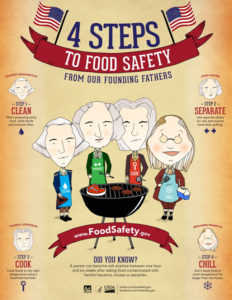Food and Fireworks
Posted in Food Safety on July 1, 2018

https://www.makefoodsafe.com/red-onions-salmonella-outbreak-sickens-326-in-us-and-canada/The Fourth of July is one of my favorite holidays. I love the time spent with family, friends, and of course, the fireworks display. I equally love the opportunity to wear the worn and faded Old Navy Fourth of July t- shirt that has many memories attached to it. I also love the fact that food – really good food, is involved. What is more celebratory than a good old barbecue? Food and Fireworks!
Which brings me to the fact that here at Make Food Safe, it is always uppermost in our minds to provide information to keep you and your family and friends safe during the upcoming holiday and all throughout the year. The following information pertains to understanding various food pathogens and implementing important food safety practices this Fourth of July.
Food “Fireworks” Are Not the Way to Celebrate
As a former victim of food poisoning many years ago, I can say with certainty that you absolutely and unequivocally do not want a bout with it. Put another way, after watching your local fireworks, you don’t want the fireworks going off in your intestines! The following is a list of the most popular dishes that are prepared and cooked on July Fourth and the most common foodborne illnesses associated with them. I know…who wants to hear about possibly contaminated food when all you want to do is party? Well, remember the tried and true adage, “An ounce of prevention…” Prevention is key!
- Hamburgers and Hot Dogs: Americans will fire up their respective grilling devices, having spent about $388 million dollars on hamburger patties and/or ground beef. Ground beef can be the source of nasty pathogens such as: Salmonella, Escherichia coli (E coli), Campylobacter, Listeria, and Staphylococcus. E coli O157:H7 is of particular concern when it comes to ground meat. It is a Shiga toxin-producing bacterium, which means that this strain of pathogen produces large quantities of a virulent toxin that causes severe damage to the lining of the intestine and can lead to a very dangerous condition known as Hemolytic Uremic Syndrome (HUS). The E coli bacterium can infiltrate ground meat when it is prepared at meat packing facilities and spread quickly throughout the meat when it is ground. The E coli bacterium can colonize in the intestines of slaughtered animals and thereby contaminate the meat. The bacteria can survive refrigerator and even freezer temperatures, and it only takes a small amount to cause serious illness. Proper cooking kills the bacteria, so cook to a minimum internal temperature of 160 degrees F as measured by a food thermometer. Hot dog consumption comes in at 150 million units. Also, July is National Hot Dog month! Again, proper cooking is essential: even though hot dogs are precooked, heating hot dogs until they are steaming hot will help kill listeria. Never leave hot dogs or any other food product out more than two hours, or one hour if the outside temperature is above 90 degrees F.
- Chicken: Closely followed by hamburgers and hot dogs is the ubiquitous chicken. Americans will consume nearly 750 million pounds of these cluckers over the Fourth. Unfortunately, the mass production/raising of chickens can lead to all sorts of foodborne pathogens, including Salmonella Enteritidis (often associated with poultry and shell eggs), Staphylococcus, Campylobacter, Listeria, and E. coli. You don’t need to wash your poultry before cooking. In fact, the USDA doesn’t recommend it because the bacteria in poultry juices can be spread to other foods, utensils and preparation surfaces, also known as cross-contamination. Rinsing the chicken does not get rid of bacteria: only cooking does, so cook all poultry to an internal temperature of 165 degrees F as measured by a food thermometer.
- Potato Salad, Macaroni Salad and Egg Salad: This one’s a biggie given the fact that we can become rather careless when it comes to storing these products, especially when we’re hosting company. Creamy salads are a nasty culprit when it comes to harboring bacterial pathogens, and they flourish whenever the temperature goes over 40 degrees F. Now of course 40 degrees is a bit chilly for July, but the bacteria grow very rapidly for every 5 degree increase in temperature. Egg salad is made from cooked eggs; however, when preparing your egg salad, make sure you wash your hands after handling the eggs. (Author’s note: eating creamy dressing that was contaminated due to improper refrigeration was the cause of my own food poisoning episode…). Let’s just say, Bacillus and Staphylococcus aureus are not the best ingredients for grandma’s potatoes salad.
How to Have a Fabulous and Food-Safe Fourth
One of the most effective ways to combat virtually all types of foodborne illnesses is to be proactive, and one of those is to wash hands frequently during all steps of the process from preparation of your feast to its serving. Equally important is to follow these guidelines brought to you by the marvelous folks at the Illinois Department of Health in my own home state:
- When traveling, keep your cooler below 40 degrees F by putting beverages in one and food in another.
- In the cooler, separate raw meat and poultry from fruit, vegetables, cheeses, and salads to avoid cross-contamination. You could end up with a salmonella sandwich! Make sure your cooler is out of the direct sun as well.
- Use clean utensils and a clean plate when removing cooked food from the grill. We don’t want to add an E coli marinade to those hamburgers or chicken wings!
- Being outside usually means you’ve come in contact with something (or several) things that are dirty. If you don’t have access to soap and running water, bring hand sanitizer to practice the already mentioned mantra of wash, wash, wash your hands!
- When you’ve had your fill…..chill. That means refrigerate any leftovers promptly.
For more information on food safety and foodborne illnesses and their symptoms, go to www.cdc.gov or www.fda.gov.
From our “Founding Fathers of Food Safety”:

From all of us at Make Food Safe, have a most happy Food and Fireworks and safe Fourth of July!!
By: Kerry Bazany, Contributing Writer (Non-Lawyer)

